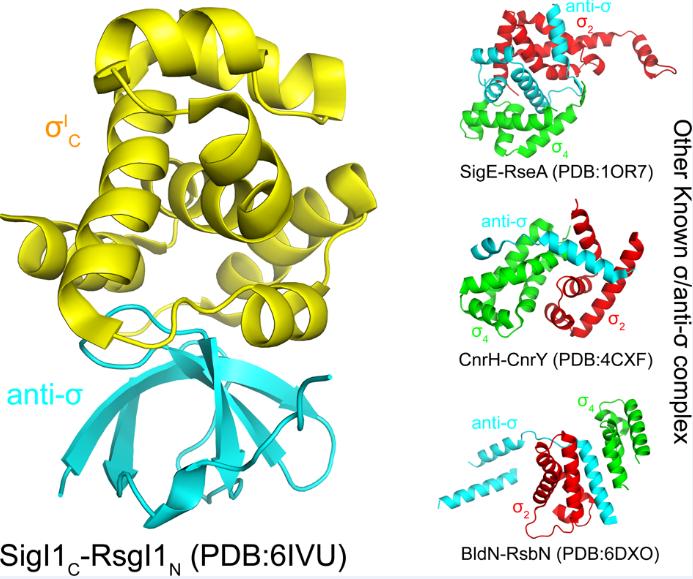
Credit: FENG Yingang and LIU Yajun
Transcription is the process of synthesizing messenger RNA by RNA polymerase based on the DNA sequence of a gene and is the initial step in gene expression. In bacteria, σ factor is a key component of RNA polymerase for promoter recognition and transcription initiation.
In recent years, a type of σ factor SigI and its co-transcribed anti-σ factor RsgI have been found widely in some Clostridia and Bacilli. They represent a new class of bacterial σ/anti-σ factors. Previous studies have shown that these SigI/RsgI factors are responsible for cellulosome regulation, while the structural and functional mechanisms of these factors are still unknown.
Prof. FENG Yingang and his colleagues from the Qingdao Institute of Bioenergy and Bioprocess Technology (QIBEBT) of the Chinese Academy of Sciences recently revealed the structural and functional mechanism of the SigI/RsgI factors from C. thermocellum. The results have been published in Nucleic Acids Research.
Cellulosomes are multi-enzyme complexes secreted by some anaerobic Clostridia and are efficient lignocellulose-degrading machines with important applications in both lignocellulose bioconversion and biotechnology development.
The synthesis of cellulosomal components is regulated along with the extracellular substrates. Thus, the study of the substrate-induced regulation mechanism is crucial for the engineering of cellulosomes aimed at high activity and their applications.
To study the mechanism of SigI/RsgI in cellulosome regulation, the researchers investigated the interaction between RsgI and SigI through nuclear magnetic resonance experiments and found that the intracellular domain of RsgI formed a stable complex with the C-terminal domain of SigI.
The three-dimensional structure of the complex is completely different from the known structures of other σ/anti-σ factor complexes, representing a new class of σ/anti-σ factor complex structure. Further structural and mutagenesis analysis revealed a critical region on SigI that recognizes the promoter -35 region DNA. The recognition specificity among different pairs of SigI/RsgI factors is achieved by the synergistic interactions between multiple pairs of residue on the two proteins.
“The SigI/RsgI factors we worked on are unique among known σ/anti-σ factors,” said FENG, the corresponding author of the study. “Our findings on these interesting regulation factors enrich our understanding of the structure and function of σ/anti-σ factors.”
“The research not only provides a better understanding of the molecular mechanism of bacterial response to the extracellular environment, but also helps to explain the regulation mechanism of cellulosomes and will promote the engineering and application of cellulosomes in the future,” said Prof. Edward A. Bayer from the Weizmann Institute of Science in Israel, co-discoverer of the cellulosome.
###
The research was supported by the National Natural Science Foundation of China, the Chinese Academy of Sciences, and Shandong Province.
Media Contact
CHENG Jing
[email protected]
Related Journal Article
http://dx.




